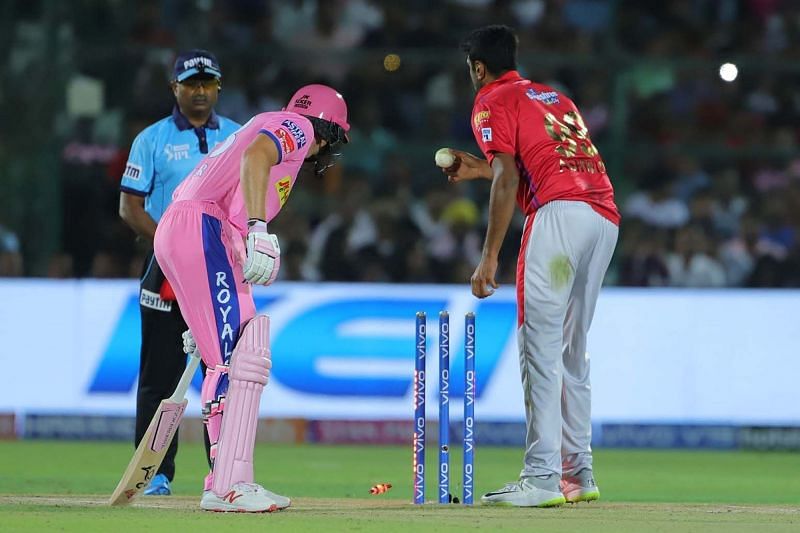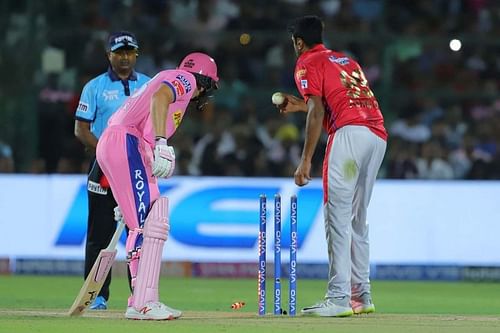
IPL 2019: Ravichandran Ashwin and the art of 'Mankading'

If you are reading this in 2030, here is a little background:
On 25th March 2019, Rajasthan Royals played Kings XI Punjab in the 4th match of IPL 2019. Batting first, Punjab scored 184 with Chris Gayle scoring 79 of those. Rajasthan were 108/1 in 12.4 overs with 76 needed off the last 44 balls.
This kind of target would normally favour the chasing team since there are 9 wickets still left. It is the sort of total MS Dhoni and CSK were hunting down in less than 5 overs all through the 2018 IPL on their way to the championship.
At this stage Jos Buttler was 'run out' by R Ashwin. But it was no ordinary run out. Buttler was out 'Mankaded'.
Here is how Wikipedia defines 'Mankading'.
"The most famous example of this method of dismissal involved the Indian bowler Vinoo Mankad. It occurred during India's tour of Australia on 13 December 1947 in the second Test at Sydney. Mankad ran out Bill Brown when, in the act of delivering the ball, he held on to it and removed the bails with Brown well out of his crease. This was the second time Mankad had dismissed Brown in this fashion on the tour, having already done it in an earlier match against an Australian XI. On that occasion he had warned Brown once before running him out.
The Australian press accused Mankad of being unsportsmanlike, although some Australians, including Don Bradman, the Australian captain at the time, defended Mankad's actions. Since this incident, a batsman dismissed in this fashion is (informally) said to have been 'Mankaded'."
It is quite interesting to note that Don Bradman, the greatest batsman of all time, defended 'Mankading'. But is this really a valid mode of dismissal? Here is how the ICC ruling interprets this.
"The bowler is permitted, before releasing the ball and provided he has not completed his usual delivery swing, to attempt to run out the non-striker. Whether the attempt is successful or not, the ball shall not count as one of the over. if the bowler fails in an attempt to run out the non-striker, the umpire shall call and signal dead ball as soon possible."
Note the key words here - "before releasing the ball". This means that the non-striker has to be within the crease till the bowler 'releases' the ball.
However, one of the key tactics used by the non-striker over the years has been to start walking as soon as the bowler hits his delivery stride. This gives them momentum to complete the first run quickly and even convert a few ones into twos.
So the real trick is to build up momentum for the run before the bowler releases the ball, but also staying within the crease. To achieve this, the non-striker needs to start his run/walk from a few steps behind the crease so that he fulfills both criteria successfully.
Cricket has often been referred to as the "gentleman's" game. This refers to the fact that the spirit of sportsmanship is usually held above everything else. As part of this 'spirit', it is said that a bowler needs to give a batsman at least one warning before he tries to get him out by 'Mankading'. That is the crux of the debate that the dismissal caused.
There are two points of view, both of which seem equally right here.
1. The bowler should just give the batsman a warning and not really get him out 'Mankaded'.
2. There is no real reason to warn. Since the batsman has not followed the ICC rule, the bowler can just get him out 'Mankaded'.
As with every debate, it is a tough one to decide. Logic says the second option is the right one since we are following the rule. Emotion says the first option is the right one since the batsman was not really gaining anything here and so to get him out this way is not fair.
As with every debate between logic and emotion, it is often emotion that ends up the winner. Cricketers around the world have panned Ashwin for this move.
Was Ashwin wrong though? I don't think so. He just did what was stated in the ICC book. However, what this act should really do is hurry up the rewriting of the rule to clearly state what behaviour is expected here.
This is 2019. Computers and machines have changed our lives. As computers do all their thinking in binary 0 and 1, so too must humans evolve to have a clear direction.
That is the right thing to do as there is no place for taking decisions based on 'spirit of the game', where each individual's interpretation of the rule is different.
And now to the result of this match. Did 'Mankading' cause any difference to the result? Here's how it went.
Post this dismissal, Rajasthan never got the momentum back. They lost 8 wickets for 62 runs and ended up losing the match by 14 runs. The dismissal of Buttler turned out to be the game changer.
Should we allow such a key moment to be decided by the 'spirit of the game'? I guess not.